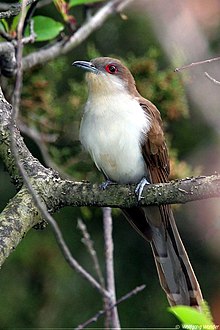Coccyzus
| Coccyzus | |
|---|---|
 |
|
| Black-billed cuckoo (Coccyzus erythropthalmus) | |
| Scientific classification | |
| Kingdom: | Animalia |
| Phylum: | Chordata |
| Class: | Aves |
| Order: | Cuculiformes |
| Family: | Cuculidae |
| Genus: |
Coccyzus Vieillot, 1816 |
| Species | |
|
13, see text |
|
| Synonyms | |
|
Hyetornis |
|
13, see text
Hyetornis
Saurothera
Coccyzus is a genus of cuckoos which occur in the Americas. The genus name is from Ancient Greek kokkuzo, which means to call like a common cuckoo.
The species in taxonomic order are:
The genera Saurothera (the lizard cuckoos) and Hyetornis (chestnut-bellied and bay-breasted cuckoos) were lumped with Coccyzus by the American Ornithologists' Union in 2006.
On the other hand, the ash-colored cuckoo and dwarf cuckoo – at one time separated in Micrococcyx – have been found to be closest relatives of the little cuckoo, formerly in Piaya. These three are now again placed in the reinstated genus of the latter, Coccycua.
These birds are of variable size with slender bodies, long tails and strong legs. Many have black and white undertail patterns. They occur in a variety of forests, woodlands or mangroves.
Coccyzus cuckoos, unlike many Old World species, build their own nests in trees and lay two or more eggs. Yellow-billed and black-billed cuckoos occasionally lay eggs in the nests of other birds, but are not obligate brood parasites like the common cuckoo of Eurasia.
Northern species such as yellow-billed and black-billed cuckoos are strong migrants, wintering in Central or South America, and occasionally wander to western Europe as rare vagrants, but the tropical Coccyzus cuckoos are mainly sedentary.
...
Wikipedia
